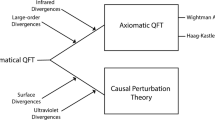Abstract
Asymptotic behaviors of zero modes of the massless Dirac operator H = α · D + Q(x) are discussed, where α = (α1, α2, α3) is the triple of 4 × 4 Dirac matrices, \(D = \frac{1}{i } \nabla_x\), and Q(x) = (q jk (x)) is a 4 × 4 Hermitian matrix-valued function with | q jk (x) | ≤ C 〈x〉−ρ, ρ > 1. We shall show that for every zero mode f, the asymptotic limit of |x|2 f (x) as |x| → + ∞ exists. The limit is expressed in terms of the Dirac matrices and an integral of Q(x) f (x).
Similar content being viewed by others
References
Adam C., Muratori B. and Nash C. (1999). Zero modes of the Dirac operator in three dimensions. Phys. Rev. D 60: 125001-1–125001-8
Adam C., Muratori B. and Nash C. (2000). Degeneracy of zero modes of the Dirac operator in three dimensions. Phys. Lett. B 485: 314–318
Adam C., Muratori B. and Nash C. (2000). Multiple zero modes of the Dirac operator in three dimensions. Phys. Rev. D 62: 085026-1–085026-9
Balinsky A.A. and Evans W.D. (2001). On the zero modes of Pauli operators. J. Funct. Anal. 179: 120–135
Balinsky A.A. and Evans W.D. (2002). On the zero modes of Weyl–Dirac operators and their multiplicity. Bull. Lond. Math. Soc. 34: 236–242
Balinsky, A.A., Evans, W.D.: Zero modes of Pauli and Weyl–Dirac operators. In: Advances in differential equations and mathematical physics, Birmingham, 2002, pp. 1–9, Contemp. Math., 327. American Mathematical Society Providence, 2003
Bugliaro L., Fefferman C. and Graf G.M. (1999). A Lieb-Thirring bound for a magnetic Pauli Hamiltonian, II. Rev. Mat. Iberoamericana 15: 593–619
Elton D.M. (2002). The local structure of zero mode producing magnetic potentials. Commun. Math. Phys. 229: 121–139
Erdös L. and Solovej J.P. (2001). The kernel of Dirac operators on \({\mathbb S}^3\) and \({\mathbb R}^3\) Rev. Math. Phys. 13: 1247–1280
Erdös L. and Solovej J.P. (2004). Uniform Lieb–Thirring inequality for the three-dimensional Pauli operator with a strong non-homogeneous magnetic field. Ann. Henri Poincaré 5: 671–741
Erdös L. and Solovej J.P. (2004). Magnetic Lieb-Thirring inequalities with optimal dependence on the field strength. J. Stat. Phys. 116: 475–506
Fröhlich J., Lieb E.H. and Loss M. (1986). Stability of Coulomb systems with magnetic fields. I. The one-electron Atom. Commun. Math. Phys. 104: 251–270
Loss M. and Yau H.T. (1986). Stability of Coulomb systems with magnetic fields. III. Zero energy bound states of the Pauli operators. Commun. Math. Phys. 104: 283–290
Saitō Y., Umeda T.: The zero modes and zero resonances of massless Dirac operators. Hokkaido Math. J. http://front.math.ucdavis.edu/0612.5678 (to appear in Hokkaido Math. J.)
Author information
Authors and Affiliations
Corresponding author
Rights and permissions
About this article
Cite this article
Saitō, Y., Umeda, T. The Asymptotic Limits of Zero Modes of Massless Dirac Operators. Lett Math Phys 83, 97–106 (2008). https://doi.org/10.1007/s11005-007-0207-6
Received:
Accepted:
Published:
Issue Date:
DOI: https://doi.org/10.1007/s11005-007-0207-6



